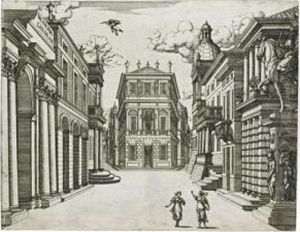Giacomo Torelli Paintings
Giacomo Torelli was an Italian stage designer, engineer, and architect, born in Fano, Italy, in 1608. He is renowned for his innovative contributions to theatre architecture and stage machinery, particularly during the Baroque period. Torelli's work significantly influenced the development of scenic design and the use of mechanical devices in theatre, making him a pivotal figure in the evolution of stagecraft.
Torelli moved to Venice in the 1640s, where he became involved in the production of operas. His designs and machines for these productions were groundbreaking, allowing for rapid scene changes and the creation of elaborate visual effects. One of his most famous inventions was the 'chiaroscuro' machine, which enabled scenes to be changed in full view of the audience, a technique that astonished contemporary viewers and set new standards for theatrical spectacle.
In 1645, Torelli published 'Le machiné e le scenografie,' a treatise that detailed his designs and inventions, further cementing his reputation as a master of stagecraft. His work caught the attention of the French court, and in 1645, he was invited to Paris by Cardinal Mazarin to produce court ballets. There, Torelli designed the stage for the Palais-Royal Theatre, introducing his innovative machinery to the French stage, including the use of counterweight systems for flying scenery and performers.
Torelli returned to Italy in 1652, where he continued to work on numerous theatrical productions, employing his skills in stage design and machinery to create visually stunning and technologically advanced performances. His contributions to the arts were not limited to theatre; he was also involved in the design of festival decorations and architectural projects. Giacomo Torelli died in Fano in 1678, leaving behind a legacy as one of the most influential stage designers of the 17th century. His work paved the way for future developments in theatre technology and set design, influencing generations of stage designers and architects.
